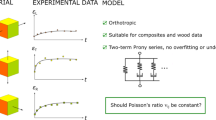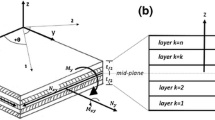Abstract
To investigate the effect of fluctuating temperatures on the creep strain of wood–plastic composites, a full-scale, long-term creep test was conducted in an unconditioned environment. However, the effect of elevating temperature caused unexpected additional increases in strain. In this study, the previously developed stress–temperature incorporated creep model and the proposed temperature-induced strain superposition method were employed in combination. The temperature-induced additional strain was successfully simulated, indicating that the creep test under an ambient environment could successfully simulate long-term creep with increasing temperatures. This approach and the concept can be applied to comparable future studies.
Similar content being viewed by others
References
Chambers RS (1997) RELFIT: A program for determining Prony series fits to measured relaxation data. Sandia Report SAND97-0371. Sandia National Laboratories
Chang F-C, Lam F, Englund KR (2010) Feasibility of using mountain pine beetle attacked wood to produce wood–plastic composites. Wood Fiber Sci 42(3):388–397
Chang F-C, Lam F, Kadla JF (2013) Using master curves based on time–temperature superposition principle to predict creep strains of wood–plastic composites. Wood Sci Technol 47:571–584
Chang F-C, Lam F, Kadla JF (2014) The effect of temperature on creep behavior of wood–plastic composites. J Reinf Plast Compos 33(9):883–892
Chen T (2000) Determining a Prony series for a viscoelastic material from time varying strain data. NASA report. NASA/TM-2000-210123
Cowie JMG (1973) Polymers: Chemistry and physics of modern materials. Intext Educational Publishers, New York, pp 223–245
Dastoorian F, Tajvidi M, Ebrahimi G (2010) Evaluation of time dependent behavior of a wood flour/high density polyethylene composite. J Reinf Plast Compos 29(1):132–143
Findley WN, Lai JS, Onaran K (1989) Creep and relaxation of nonlinear viscoelastic materials with an introduction to linear viscoelasticity. Dover, New York
McCrum NG, Buckley CP, Bucknall CB (1997) Principles of polymer engineering, 2nd edn. Oxford University Press Inc., New York
Pooler DJ, Smith LV (2004) Nonlinear viscoelastic response of a wood–plastic composite including temperature effects. J Thermoplast Compos Mater 17:427–445
Pramanick A, Sain M (2006) Temperature-Stress equivalency in nonlinear viscoelastic creep characterization of thermoplastic/agro-fiber composites. J Thermoplast Compos 19(1):35–60
Pulngern T, Chitsamran T, Chucheepsakul S, Rosarpitak V, Patcharaphun S, Sombatsompop N (2016) Effect of temperature on mechanical properties and creep responses for wood/PVC composites. Constr Build Mater 111:191–198
Schapery RA (1969) On the characterization of nonlinear viscoelastic material. Polym Eng Sci 9(4):295–310
Tajvidi M, Falk RH, Hermanson JC (2005) Time–temperature superposition principle applied to a kenaf-fiber/high-density polyethylene composite. J Appl Polym Sci 97:1995–2004
Tajvidi M, Motie N, Rassam G, Falk RH, Felton C (2010) Mechanical performance of hemp fiber polypropylene composites at different operating temperatures. J Reinf Plast Compos 29(5):664–674
Wang WH, Huang HB, Du HH, Wang H (2015) Effects of fiber size on short-term creep behavior of wood fiber/HDPE composites. Polym Eng Sci 55(3):693–700
Acknowledgements
Authors acknowledge Forestry Innovation Investment Ltd., British Columbia, Canada, for providing financial support to this study.
Author information
Authors and Affiliations
Corresponding author
Additional information
Publisher's Note
Springer Nature remains neutral with regard to jurisdictional claims in published maps and institutional affiliations.
Rights and permissions
About this article
Cite this article
Chang, FC., Lam, F. Effects of temperature-induced strain on creep behavior of wood–plastic composites. Wood Sci Technol 52, 1213–1227 (2018). https://doi.org/10.1007/s00226-018-1033-y
Received:
Published:
Issue Date:
DOI: https://doi.org/10.1007/s00226-018-1033-y










